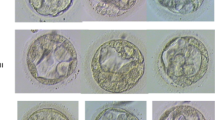Abstract
Two hundred eighteen consenting patients entered a randomized study of the application of chemical zona pellucida thinning on their day 3 embryos, prior to uterine transfer. Of those control patients (n =108), whose embryos remained unmanipulated, 40 (37.0%) have ongoing/delivered pregnancies, while in the experimental group (n =110), whose embryos had their zonae pellucidae chemically thinned, there are 49 patients (44.6%) who have ongoing/delivered pregnancies. Although this difference is not significant, clearly the application of this micromanipulative intervention has not been detrimental, and this bodes well for routine application of embryonic micromanipulation procedures in general. Certain patient subgroups were studied including older women, those with elevated basal follicle stimulating hormone levels, patients with embryos of differing zona thickness, and patients with embryos of differing uniformity of zona thickness. No significant influence of chemical removal of the outside of the zona on the implantation rate of embryos in any of these subgroups was observed other than a marginally significant (P =0.095) improvement of implantation of embryos with less than 4.0 µm variation in zona thickness when chemical zona thinning was applied. Failure of chemical zona thinning to enhance human embryo implantation significantly, compared to assisted hatching by complete zona drilling, strongly suggests that the bilayered human zona pellucida needs to be fully breached, unlike that of the mouse.
Similar content being viewed by others
References
Cohen J, Alikani M, Trowbridge J, Rosenwaks Z: Implantation enhancement by selective assisted hatching using zona drilling of human embryos with poor prognosis. Hum Reprod 1992;7:685–691
Cohen J, Elsner C, Kort H, Malter H, Massey J, Mayer MP, Wiemer K: Impairment of the hatching process following IVF in the human and improvement of implantation by assisting hatching using micromanipulation. Hum Reprod 1990;5:7–13
Khalifa E-AM, Tucker MJ, Hunt P: Cruciate thinning of the zona pellucida for more successful enhancement of blastocyst hatching in the mouse. Hum Reprod 1992;7:532–536
Tucker MJ, Cohen J, Massey JB, Mayer MP, Wiker SR, Wright G: Partial dissection of the zona pellucida of frozenthawed human embryos may enhance blastocyst hatching, implantation, and pregnancies. Am J Obstet Gynecol 1991;65:341–345
Cohen J, Alikani M, Reing AM, Ferrara TA, Trowbridge J, Tucker M: Selective assisted hatching of human embryos. Ann Acad Med 1992;21:565–570
Cohen J, Malter H, Elsner C, Kort H, Massey J, Mayer MP: Immunosuppression supports implantation of zona dissected human embryos. Fertil Steril 1990;53:662–665
Wright G, Wiker S, Elsner C, Kort H, Massey J, Mitchell D, Toledo A, Cohen J: Observations on the morphology of pronuclei and nucleoli in human zygotes and implications for cryopreservation. Hum Reprod 1990;5:109–115
Tucker M, Elsner C, Kort H, Massey J, Mitchell-Leef D, Toledo A: Poor implantation of cryopreserved reinsemination-fertilized human embryos. Fertil Steril 1991;56:1111–1116
Gordon JW, Talansky BE: Assisted fertilization by zona drilling: A mouse model for correction of oligospermia. J Exp Zool 1986;239:347–354
Dunbar BS, Maresh GA, Washenik K: Ovarian development and the formation of the mammalian zona pellucida.In The Mammalian Egg Coat, J Dietl (ed). Berlin, Springer-Verlag, 1989, pp 38–48
Sathananthan AH, Trounson AO, Wood C: Atlas of Fine Structure of Human Sperm Penetration, Eggs and Embryos Cultured in Vitro. New York, Praeger Scientific, 1986, pp 70–71
Chan PJ: Development potential of human oocytes according to zona pellucida thickness. J Vitro Fert Embryo Transfer 1987;4:237–241
Author information
Authors and Affiliations
Rights and permissions
About this article
Cite this article
Tucker, M.J., Luecke, N.M., Wiker, S.R. et al. Chemical removal of the outside of the zona pellucida of day 3 human embryos has no impact on implantation rate. J Assist Reprod Genet 10, 187–191 (1993). https://doi.org/10.1007/BF01239219
Received:
Accepted:
Issue Date:
DOI: https://doi.org/10.1007/BF01239219




